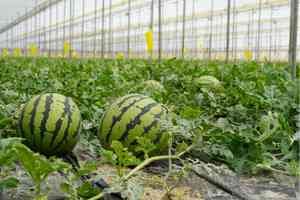Watermelons that are sweet, juicy, and homegrown capture the essence of summer with a flavor that is unmatched by those that are purchased from a store. Like their cantaloupe relatives, watermelons require 2 to 3 months of heat to develop ripe fruit, making watermelon cultivation in northern climates difficult but not impossible. However, any gardener can enjoy the sweetness of homegrown watermelons by utilising floating row covers to trap warm air near plants and plastic mulch to warm the soil.
Watermelon plants are more common in warmer climates with long growing seasons since they require a long period of warm weather to grow well. However, by buying young plants from a nursery, and cultivating shorter-season types, gardeners in colder areas can still grow watermelons. Depending on the type, watermelon plants might take between 70 and 100 days from planting to harvest.
Watermelon plant facts
| Scientific Name | Citrullus lanatus |
| Common Name | Watermelon |
| Plant Type | Annual fruiting vine |
| Sun Exposure | Full sun |
| Size | 9 to 18 inches tall; 10- to 15-foot vine spread |
| Soil Needs | Loamy, sandy, well-drained |
| Soil pH | Slightly acidic to neutral (6.0 to 6.8) |
| Native Area | Western Africa |
| Hardin=ess Zones | Grown as an annual in zones 2 to 11 |
When to plant watermelons?

- Start seeds two to three weeks before the last date of your growing season in excellent locations with short growing seasons. Then, when the soil reaches at least 65°F (18°C) or two weeks beyond that date, plan to transfer seedlings into the garden.
- If your last frost date was in a warmer region with a long growing season, you could sow seeds outside immediately afterward as long as the soil has warmed to at least 65°F (18°C).
- Nurseries are another place to purchase young watermelon plants. These should only be planted after there is no longer a possibility of a frost because they are pretty delicate. Watch the local forecast and take extra precautions. Think about draping black plastic over the planting area to warm the soil further.
Choosing and preparing a planting site
- Before planting, add compost, seaweed, or old manure to the soil. Due to their intense feeding habits, watermelons require healthy soil with a high concentration of nutrients. Find out more about soil improvements and getting the ground ready for planting.
- Loamy, moderately sandy, well-drained soil is ideal for watermelons. However, it may struggle when the soil is excessively clayey and poorly drained.
- In the range of 6.0 and 7.5 (“slightly acidic to neutral”), watermelons thrive in soil.
- Each watermelon plant requires up to 20 square feet. So, plant them in an area where they won’t encroach on other crops because their vines need space to spread out.
- The hills created by growing the vines in higher rows provide proper drainage and prolong the effectiveness of the sun’s heat.
- The plants should be placed on a slope 5 feet wide and 2-3 feet apart.
- Put your traditional row-grown crops at least 6 feet apart.
How to plant watermelons?
- Plant seeds 1/4 to 1/2 inch deep in seed-starting pots indoors or 1/2 to 1 inch deep outside.
- If direct sowing outside, plant 4 to 6 seeds per hill and thin to 2 to 3 seedlings later.
Transplanting seedlings
- When transplanting watermelon seedlings, handle them with the utmost care. When taking them out of pots, be careful not to disrupt the soil because their roots are extremely delicate.
- Row coverings should be placed over the plants after transplanting to prevent pest infestation. When you notice both male and female flowers on the vine, don’t forget to take the row covers off so pollinators may access the blossoms.
How to grow watermelons?

Watering
From the time of planting until fruit starts to form, watering is crucial. Watermelon plants require 1 to 2 inches of water daily when growing, flowering, and bearing fruit. In addition, you have to keep the soil wet but not soggy. In the morning, water the vines at their base, careful not to wet the foliage or water from above. Once the fruit is grown, watering can be reduced. The sweetest melon is produced in dry climates.
Fertilising
You have to ensure the fertilizer supplies more nitrogen than phosphate and potassium if you choose to fertilize (and many people do), as this will promote the growth of leaves and vines. Use a fertilizer with less nitrogen to encourage flowers and fruit after flowering starts. You will enjoy using a fertilizer made from seaweed.
Fruit and flowering
On the same plant, vines generate different male and female flowers. Several weeks before the female flowers develop, they frequently start to produce male blooms. If the male flowers fall off, it is normal. The female buds will remain on the vine and produce fruit; they have a swelling bulb at the base. Be gentle to the bees since blossoms need pollination to produce fruit. Discover ways to help pollinators in your backyard. For example, put cardboard or straw between the fruit and the earth as it ripens to keep it from decaying.
Basic instructions
Adding a black plastic or straw layer around the plants can warm the soil, stop weed growth, and keep developing fruits off the ground. Watermelon plants don’t often require pruning, but if you prevent lateral (side) vines from growing and adhering to the main vine, vine yield may be increased. Prune the plant’s terminal buds as they form when it is young (before the side shoots become vines). To concentrate energy on fewer melons, you can pinch off some petals. However, it can be challenging to eradicate a prospective fruit.
Watermelon plant care
Light
For watermelons to thrive, they need whole light. In hotter climes, the plants may withstand some partial shade, but the melons need a lot of sun to produce their sugars. Therefore, the quantity and size of the fruits will be reduced in very shady situations.
Soil
Watermelon plants thrive on practically any fertile, well-draining soil. The ideal soil pH range is between 6.0 and 6.8, which ranges from mildly acidic to neutral. Before planting, it is recommended to heavily amend the soil with lots of organic matter because these plants are heavy eaters.
Water
When watermelons are first transplanted, they require regular watering. However, you can cut back on the water after they start producing fruit unless the season is arid. They can tolerate brief dry spells thanks to their strong roots. However, if given too much water, they will lose their deliciousness.
Temperature and humidity
The 80 degrees Fahrenheit or higher growth temperatures are preferred for watermelons. However, they will thrive in humid and dry situations if sufficient soil moisture.
Fertiliser
Watermelon plants consume a lot of food. Before planting, ensure your soil has been adequately supplemented with organic matter. When the season begins, add a slow-release organic fertilizer if your soil is deficient in organic matter. In addition, add a layer of compost to the sides of watermelons in the middle of the season to maintain steady growth.
To promote the growth of the leaves and vine, if you decide to use chemical fertilizer, feed your plants early on with a fertilizer that includes more nitrogen than phosphate and potassium. However, treat again when flowering starts using a low-nitrogen fertilizer to promote the growth of flowers and fruit.
Benefits and risks of eating watermelon
It helps to relax skin
The vitamins A, B6, and C in watermelon help maintain your skin’s health and suppleness. Watermelon fruit also works well as a face mask because it is very high in water.
Stronger heart
Citrulline, an abundant amino acid in watermelon, may aid blood circulation and reduce blood pressure. The benefits of all the lycopene that Watermelon fruit contains are also enjoyed by your Heart. So make sure to exercise, quit smoking, consume less saturated fat, and adhere to your doctor’s recommendations.
Fully Lycopene-rich
The antioxidant lycopene is what gives the food its vivid red color. Studies show that including it in your healthy lifestyle can lower your risk of developing cancer and diabetes. Including tomatoes, watermelon has more of this vitamin than any other fruit or vegetable. To get more lycopene, pick a melon with bright red flesh rather than one that is yellow or orange. Better still is the riper. Furthermore, lycopene concentrations in melons with and without seeds often vary.
Protects Joints
Your joints may experience less inflammation if you consume beta-cryptoxanthin, a naturally occurring pigment found in watermelon. In addition, a study suggests that it may lower your risk of developing rheumatoid arthritis.
Good for Eyes
One medium slice of watermelon tree provides 9–11% of the daily recommended amount of vitamin A. This nutrient is necessary to keep your eyes healthy. The fruit watermelon is an excellent method to get all the vitamins and minerals your body requires.
Risk factors
Most people don’t experience significant health hazards with moderate watermelon consumption, while others may want to use caution.
Diabetes
A fruit with natural sugar content in watermelon. The everyday diets of people with diabetes must contain these carbs. Juicing watermelon removes the fiber, making the sugar more straightforward for the body to absorb; hence it is better to eat the fruit whole. However, the likelihood of a glucose spike may rise as a result. As with other fruits and drinks, be mindful of portion quantities.
Allergy
After consuming watermelon fruit, some people may get allergic response symptoms like hives, edema, and breathing difficulties. If this happens, the individual needs medical attention since allergy, a condition that can be fatal is sometimes caused by this.
Types of watermelon plant
Every type of watermelon has a distinctive rind and luscious, mouthwatering flesh that quenches the thirst. Some watermelon varieties have various colored shells and meat, while others have higher sugar content and are sweeter. Most of you are familiar with the dark green, oblong watermelon with brilliant ruby red pulp, although melons can also be light pink, yellow, or even orange. Watermelons range in size from tiny 5-pounders (2 kg) to enormous 200-pounders (91 kg.).
Watermelons come in four basic types: seedless, picnic, Icebox, and yellow or orange-fleshed.
-
Seedless Watermelons
In the nineties, seedless watermelon plants were developed for those of you who don’t find spitting melon seeds amusing. Finally, a melon that rivals the sweetness of seeded varieties has been produced via successive breeding, yet low seed germination has not significantly improved. It takes a little more work to grow seedless varieties than it does to plant a seed and wait for it to sprout. Until emergence, the origin must be maintained at a steady 90 degrees F (32 C).
Seedless melons include:
- Queen of Hearts
- King of Hearts
- Jack of Hearts
- Millionaire
- Crimson
- Trio
- Nova
Despite their name, seedless watermelons do contain little, quickly-eaten seeds. The melons typically mature in 85 days and weigh 10 to 20 pounds (4.5 to 9 kg).
-
Picnic Watermelons
The Picnic type of watermelon is another option; it often weighs between 16 and 45 pounds (7 and 20 kilograms) or more, making it ideal for a picnic. These classic oblongs or round melons mature at about 85 days with a green rind and sweet, crimson flesh.
Some varieties here include:
- Charleston Gray
- Black Diamond
- Jubilee
- All sweet
- Crimson Sweet
-
Icebox Watermelon
Since they are developed to serve one person or a small family, Icebox watermelons, which weigh 5 to 15 pounds, are significantly smaller than their rivals (2-7 kg.). There are two varieties of these watermelon plants: Sugar Baby and Tiger Baby. While Sugar Babies have a sweet pulp and dark green rinds, Tiger Babies mature to a golden color in roughly 75 days. In 1956, the first batch of Sugar Babies was made.
-
Yellow and orange watermelons
Last but not least, we have round, seedless, or seeded kinds of yellow/orange-skinned watermelon plants.
Seeded varieties include:
- Desert King
- Tender gold
- Yellow Baby
- Yellow Doll
Honey heart and Chiffon are two seedless kinds. As you might have imagined, the color of the flesh varies depending on the type. In roughly 75 days, these melons reach maturity.
Troubleshooting
Watermelons belong to the same plant family as cucumbers and squash, but they do not successfully cross-pollinate. Because bees are necessary to pollinate the flowers in your garden, cool, cloudy weather in the spring will hinder their growth because bees are less active under these circumstances. Wait patiently for the weather to warm up.
On melon leaves, fungi can quickly multiply. Spots are produced on leaves by gummy stem blight, anthracnose, and Alternaria leaf spot, while stem blight also causes tan or bleached parts on stems and decay on fruit. While powdery mildew results in white patches on leaves, downy mildew develops yellow or light green leaf spots. Fungicides are used to treat fungal illnesses. You must find out which fungicides are legal in your state to use against the disease you’re fighting by contacting your neighborhood garden center or Extension Service.
Additionally, keep an eye out for pests. For instance, melon aphids can quickly invade a vine, so check leaf undersides daily. If you see any aphids, use insecticidal soap to kill them. Watermelon beetles with spots and stripes can attack plants and spread the bacterial wilt disease, which kills vines and renders them incapable of regrowing. Use rotenone or an insecticide containing pyrethrum to treat adult beetles; apply at dusk to protect honey bees.
Harvest and storage
Usually, watermelon trees take two weeks to ripen. The rest won’t take long to mature after one melon does. Water sparingly as necessary to prevent vines from wilting about a week before a melon is ready to harvest. Sugars in the fruit concentrate when water is withheld from it. A surplus of water dilutes sweetness. The color of a watermelon’s skin indicates how ripe it is.
Additionally, the rind turns from a vivid to a dull green, and the area that comes into contact with the soil transforms from greenish white to a rich, creamy yellow. Rapping on a watermelon’s skin and listening for a low-pitched thud are other ways gardeners determine a fruit’s ripeness. However, the rap on a few unripe bananas trains your ears to the wrong sound. Fruits that aren’t ripe produce a high-pitched, tinny sound.
Watermelons stay for two to three weeks without refrigeration. To extend their holding period, put them in a cool basement. After chopping, put any leftovers in the fridge. You can freeze the flesh in balls or diced pieces for slushies if you have leftover melons.
FAQs
Can you grow watermelons on a trellis?
How do you know when to harvest a watermelon?
Tap the melon with the back of your hand. A high, harsh sound indicates that the melon is not yet ripe. If the sound is monotonous and hollow, the melon is mature. The tendril nearest to the melon must be alive and green to be considered unripe. The tendril that indicates the melon's ripeness dries up and becomes brown. In addition, look for yellowing in the area where the melon is lying on the ground.
Are watermelon plants replanted each year?
No. Since watermelon is annual, it must be planted again every summer.
How are watermelons grown from seeds?
Watermelon plants grow so well from seed that you'll have difficulty finding seedlings at a garden center. So go ahead and get a packet of seeds and let's get sprouting.
Do your watermelon plants need fertilizer?
Due to their strong feeding habits, watermelon plants can benefit from routine fertilizer. While the plants are developing their stems, leaves, and canopy, we advise using a nitrogen-rich fertilizer, such as diluted fish emulsion. However, you can switch to a fertilizer with a higher phosphorus and potassium content after the plants begin to set fruit to aid in promoting fruit set.
Housing News Desk is the news desk of leading online real estate portal, Housing.com. Housing News Desk focuses on a variety of topics such as real estate laws, taxes, current news, property trends, home loans, rentals, décor, green homes, home improvement, etc. The main objective of the news desk, is to cover the real estate sector from the perspective of providing information that is useful to the end-user.
Facebook: https://www.facebook.com/housing.com/
Twitter: https://twitter.com/Housing
Email: [email protected]












